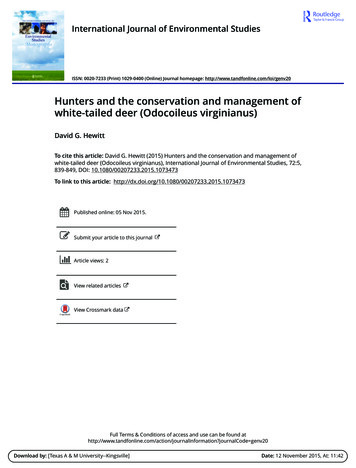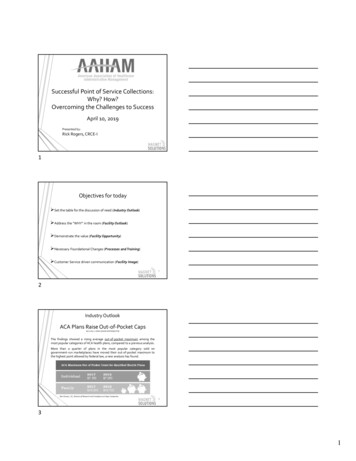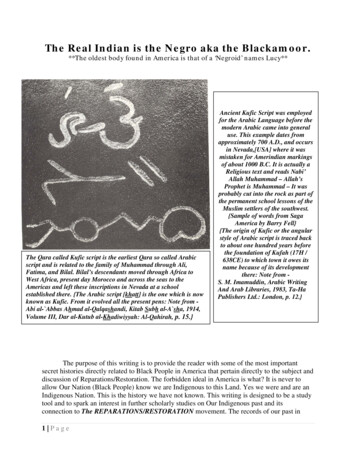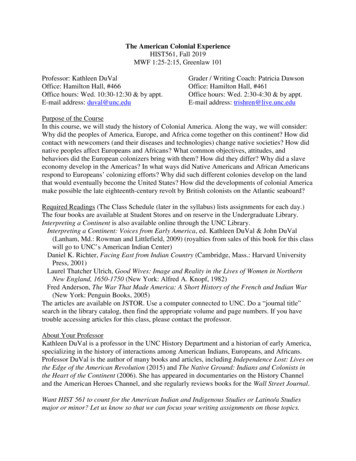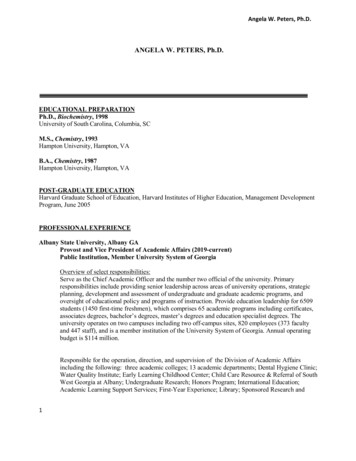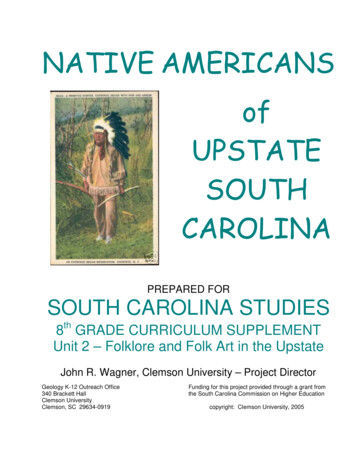
Transcription
NATIVE AMERICANSofUPSTATESOUTHCAROLINAPREPARED FORSOUTH CAROLINA STUDIES8th GRADE CURRICULUM SUPPLEMENTUnit 2 – Folklore and Folk Art in the UpstateJohn R. Wagner, Clemson University – Project DirectorGeology K-12 Outreach Office340 Brackett HallClemson UniversityClemson, SC 29634-0919Funding for this project provided through a grant fromthe South Carolina Commission on Higher Educationcopyright: Clemson University, 2005
DO NOT USE THIS PAGE – PLACEHOLDER ONLYcopyright: Clemson University, 2005Unit 2 supplement; page 0
THE CHEROKEE NATIONThe first human inhabitants of the state of South Carolina were the Native Americans (who were calledIndians by the Europeans). While much of their history has been lost, historians and archeologists have been ableto identify a number of these nations (formerly called tribes). Before the arrival of the Europeans, these peoplesurvived mainly through hunting, fishing, and farming. The Cherokee nation was the largest single NativeAmerican nation in the south, and one of the largest nations anywhere north of Mexico. The Cherokee peoplemost likely migrated south from their earliest encampment somewhere in the northeast part of North Americathousands of years ago. They originally called themselves “Ani Yunwiya,” which meant the “Principal People.”However, in the historic period, they became known as the “Cherokee.”From earliest times, the Cherokee were a mountain people who lived on both sides of the southernAppalachians. Though concentrated in the area of the current states of Tennessee and North Carolina, they alsowere located in parts of South Carolina, Georgia, Alabama, and Virginia. Today, many places in these states stillcarry the names and perpetuate the memories of these people.The Cherokees had their first encounter with Europeans when the De Soto expedition moved into theCarolinas from Florida in 1540. With the European settlement of the Southern Colonies, contact and tradebetween the Cherokee and colonists increased. In exchange for deerskins, the Cherokee obtained guns,ammunition, metal tools, clothing, and rum. In 1730 Sir Alexander Cuming took seven of the Cherokee with himto England. In 1738, Native Americans first encountered the disease smallpox, which the Europeans had broughtto the colonies. This disease wiped out almost half of the Cherokee population.In 1759 the Cherokee’s relationship with the colonists turned hostile when the Governor of SouthCarolina attempted to find and execute two Native Americans he charged with killing a white man. When theCherokee would not deliver the two accused men, as well as 24 other Indian chiefs the Governor claimed hadsuspicious intentions, war ensued. The Cherokee warriors were defeated a year later by a larger colonial army ledby Col. James Grant and were forced into a truce after many of the Middle Cherokee settlements were burned.The Cherokee also fought a number of wars against neighboring Native American nations during this period.During the Revolutionary period, the Cherokee were allied with the British, and the new patriotgovernments in North and South Carolina forced them to cede large portions of their land. In the first part of thenineteenth century, the Cherokee developed a culture that paralleled that of southern whites and adopted agovernment modeled on the United States. In 1821, a Cherokee scholar named Sequoya developed an alphabetfor the Cherokee nation that was unique among Native American nations in North America.However, white settlers continued to pour into Cherokee lands, especially when gold was discovered nearpresent day Dahlonega, Georgia in 1829. On December 29, 1835, at New Echota, a small minority of Cherokeechiefs signed away all their lands east of the Mississippi River and agreed to be removed to lands to be set apartfor them in the West. It was in 1838 that the United States government began the forced removal of theCherokee, known in American history as the “Trail of Tears.” It has been estimated that over 4,000 Cherokeedied on the “Trail of Tears.” Several hundred Cherokee escaped into the mountains of North Carolina.Eventually, they obtained permission to remain and the Quella Indian Reservation was officially recognized in1848. Today these Cherokee are known as the nation of the Eastern Cherokee.Once removed to the western “Indian Territory,” the Cherokee’s troubles continued. They were torn bydisputes between various factions and the Civil War divided them as well. Then, in 1887, Congress passed theDawes Act, which divided the western tribal lands into individual allotments. The Western Cherokee lost morethan six and one-half million acres of their land through swindles and frauds. On March 3, 1906, the Cherokeenation’s government was ended and in 1907 this land became part of the new state of Oklahoma. In 1924, allCherokee became American citizens.Today, in spite of the hardships and troubles they have faced, the Cherokee have been able to preservemuch of their cultural heritage. There are numerous reasons that the great Cherokee nation is one of the most wellknown groups of Native Americans. The Cherokee were the only nation to create its own alphabet withoutEuropean influence, the Cherokee named counties in 11 states including South Carolina, and the Cherokee left alegacy in great men who descended from them, such as Sequoyah, Senator Robert Owen and Will Rogers.(Cherokee history narrative excerpted from a paper by Larry Greer)copyright: Clemson University, 2005Unit 2 supplement; page 1
CHEROKEE TOWNS AND VILLAGES IN SOUTH CAROLINAIn 1650 there were about 22,000 Cherokee altogether, but that population dropped to almost 11,210 by1715. There were about 60 different Cherokee villages located in the Southern Appalachian region and almost4,000 warriors distributed among these villages. Due to the colonists’ negative impact on the Native Americans,namely smallpox, intoxicants, and wars, the number of Cherokee decreased initially, but the tribe remained strongand 1838 estimates count about 16,542 Cherokee in the eastern United States. By 1910 this number had grown to31,489, which included at least 1,406 in the Carolinas. The number has continued to grow throughout thetwentieth century.There were in ancient times three distinct Cherokee dialects which probably corresponded in somemeasure to the three groups of towns into which early traders and explorers divided the tribe. The following listcontains most of the Cherokee settlements in South Carolina that were known to the early colonists.Lower Settlements- Old Estatoee on Tugaloo River below the junction of Chattooga and Tullalah Rivers, in Oconee County- Estatoee in the northwestern part of Pickens County- Old Keowee on Keowee River near Fort George, Oconee County- New Keowee on the headwaters of Twelve-mile Creek in Pickens County (also known as Little Keowee)- Kulsetsiyi, on Keowee River, near Fall Creek, Oconee County- Oconee, on Seneca Creek near Walhalla, Oconee County- Qualatchee, on Keowee River, Oconee County- Tomassee, on Tomassee Creek of Keowee River, Oconee County- Toxaway, on Toxaway Creek, a branch of Keowee River- Ustanali, on Keowee River below the present Fort George, Oconee CountyMiddle Settlements- Ellijay, on the headwaters of Keowee River, Oconee CountyOver-the-Hills and Valley Settlements, or Overhill Settlements- Chatuga, on Chattooga River, on the boundary between South Carolina and Georgia.- Nayuhi, probably of the Lower Settlements, on the east bank of Tugaloo River, Oconee County- Tsiyahi, on a branch of Keowee River, near the present Cheochee, Oconee CountyUnclassified or Uncertain Settlements- Canuga, apparently on Keowee River, Oconee County- Chagee, near the mouth of Chatooga Creek of Tugaloo River at or near Fort Madison, southwest Oconee County- Conoross, on Conoross Creek which enters Keowee or Seneca River from the west in Anderson County- Quacoshatchee, in northwest Pickens County- Seneca, on Keowee River about the mouth of Conneross Creek in Oconee CountySourcesHagwood, John. The Natural and Aboriginal History of Tennessee, Kingsport, TN: Kingsport Press, 1973.Josephy, Alvin, Jr. 500 Nations. An Illustrated History of North American Indians. New York: Alfred A. Knopf, 1994.King, Duane H., ed. The Cherokee Indian Nation. A Troubled History. Knoxville: The Univ. of Tennessee Press, 1986.Lewis, Thomas M. and Kneberg, Madeline. Tribes That Slumber. Indians of the Tennessee Region. Knoxville: TheUniversity of Tennessee Press, 1966.Ramsey, J.G.M. Ramsey’s Annals of Tennessee and Fain’s Index. Kingsport, Tennessee: Kingsport Press, 1926.Swanton, John R. The Indian Tribes of North America. Washington, D.C.: Smithsonian Institution Press, 1968.copyright: Clemson University, 2005Unit 2 supplement; page 2
MAP OF CHEROKEE COUNTRY DURING COLONIAL TIMES(also showing location of present day Cherokee Indian Reservation)copyright: Clemson University, 2005Unit 2 supplement; page 3
Amistad National Recreation Area (National Park Service) website http://www.nps.gov/amis/eatlatl.htm copyright: Clemson University, 2005Unit 2 supplement; page 4
Amistad National Recreation Area (National Park Service) website http://www.nps.gov/amis/estonepts.htm copyright: Clemson University, 2005Unit 2 supplement; page 5
CHEROKEE ARTS, CRAFTS, AND WEAPONRYThe atlatl (see page 4) is sometimes called a ‘spear-launcher’ or ‘spear-thrower’ and was important in hunting.Flint knapping (see page 5) is the art of shaping stone (usually chert or flint) into useful implements.Stick ball played an important part in the life of the village. Not only was it a sport, it was a means of settlingdisputes within the village and between the tribes. Instead of a war, a game of stickball would be played! Theball would be hurled at a fish atop a pole. Someone had to be on the far side to retrieve and return the serve.Cherokee Historic Village website http://wordlink.net/Cherokee/HistoricVillage.html The Blow Gun consisted of a long tube, usually constructed of a hollow reed, used to launch small darts. Afavorite source of material was river cane – a type of bamboo found in South Carolina. The Blow Gun was usedprimarily to shoot small game animals. Longer tubes provided greater accuracy.A closeup of the dart.copyright: Clemson University, 2005Here you can see just how long a blow gun really is.Unit 2 supplement; page 6
The Bow and Arrow was the most common and most important weapon used by Native Americans. NativeNorth American archery has always stood for efficiency, accuracy, variety, and beauty. Different NativeAmerican bows demand different shooting styles, some with very short draw lengths. For all longbows, the pauseat full draw should be very brief, and most should be rubbed twice a year with natural animal fat. The EasternWoodlands longbow is a deadly and accurate weapon and will last for many years if handled with appreciation.Eastern Woodlands LongbowThis bow is handmade from solid red oak. It is designed inthe Eastern Woodland's bow style in which the tips arealmost as wide as the rest of the bow. It is bound with sisalcord so that it can be shot right or left handed. This style ofbow has been used for hundreds of years by tribes such as:Cherokee, Shawnee, Delaware, Miami, Sak and Fox, theFive Nations of the Iroquois Confederacy, and many, manyothers.Arrows are made from split white oak woven in traditionalCherokee basket patterns, naturally strained accent splits oforange (blood root) and dark brown (black walnut hull). Thearrows pictured were made by accomplished basket makerand member of the Eastern Cherokee community, Eva Reed.The shoulder strap of soft comfortable pigskin was made byLarry Snell.Native North American Archery website (The Krackow Company) http://www.krackow.com/nativeamerican.html The rabbit stick is basically a throwing stick used for the taking of small game. It consists of a stick of a mediumto hard wood with one end thicker and heavier than the other. The reason for the weighted end was to impartmomentum to the stick when thrown. The Southeastern Indian Rabbit Stick used by the Catawba Nation is madefrom green saplings of hickory and was between 12 to 18 inches in length. Chief Sam Blue described its use forhunting rabbits in the "fire patch", (an area of burnt over brush): "Four or five hunters generally went together,each armed with three clubs to throw. When a rabbit tried to make its escape from the fire-patch they wouldthrow clubs at it." The club was also used to club animals when cornered in dens or brought to bay by dogs.Cherokee/Choctaw Rabbit SticksA side-wise arm motion to hit the ground ahead of therunning rabbit, flushed by men or dogs, is the mosteffective way of throwing the rabbit stick. The side-wiseflight of the thrown stick allows for a much betterchance of intercepting the target as opposed to simplythrowing it overhand, for there is more surface area tomake contact with the target.The Throwing Stick or Rabbit Stick - by Benjamin Pressleyexcerpted from WINDSONG PRIMITIVES’ website http://www.perigee.net/ benjamin/throwstick.htm copyright: Clemson University, 2005Unit 2 supplement; page 7
Hide tanning is a laborious procedure with many sequential steps. Generally, after the hides were removed fromthe animal they were soaked, stretched on a frame (shown below), scraped of any fatty material (called fleshing),oiled, re-stretched, dried, rubbed, and stretched again to leave a dry fluffy white hide. The final product is calledleather. Native Americans produced many kinds of leather and generally added different types of decoration.The photograph below is a very rare shot of Cheyenne women tanning buffalo hides in the 1870's. The woman tothe left of the photo is softening a hairless buffalo hide by pulling the skin around a rope, while the woman to theright is thinning a buffalo skin with a scraper. It is interesting to note that the tipis in the back are already made ofcanvas that had been traded for and not the traditional animal skins. The canvas seams can be clearly seen on theoriginal print.Photo courtesy of the Smithsonian Institution (negative # 90-17238).Native Americans used leather for many purposes. They tanned deer and small animal hides in a variety of ways.More information about this can be found at the following websites: tml the use of leather for pouches and bags .html general Native American costumes http://www.nativetech.org/tanning/index.html various techniques and methods for tanning used by NativeAmericanscopyright: Clemson University, 2005Unit 2 supplement; page 8
River cane weaving and basket-making were other noteworthy Cherokee craft. Most Southeastern Indiansgenerally wove by twilling (weaving the stips in such a way as to produce a pattern of parallel diagonal lines).They did use some grass and bark but their favorite material was thin pieces of the outer covering of river cane.Some of these strips were dyed black, red, or brown and used along with un-colored natural strips to produce bothangular and curvilinear designs. They made a variety of baskets, including small baskets with handles, sieves andfanners for processing hominy meal; large baskets with flared openings for carrying heavy burdens; small andlarge hampers, often with tightly fitting covers; and small baskets whose bottoms came down to a point. Theyalso twilled large cane mats, usually measuring about five feet by six feet. They used these mats for bedding, forcarpeting, to cover seats, to cover the walls and roofs of their houses, to wrap the bodies of their dead for burial,and for many other purposes. kets.html Cherokee and other Southeast Indian double woven baskets are the oldest form of basketry in the Southeast. Byvarying the under/over interval, bias (or angular) plaiting (braiding) has been used to create other decorativestructural patterns such as zigzags and diamonds. In early times, before the Cherokee were confined toreservations, making baskets was an integral part of the women's role in the community. Each family group orclan had their own distinctive basket patterns.Many Cherokee believe that weaving baskets with distinctive twill patterns honors Ka no he lv hi, the old ways.Some noteworthy ancient design patterns include “Mountain Peaks”, “Peace Pipe”, “Flowing Water” and “Man inCoffin”. It is said Cherokee baskets manifest joys, sorrows, dreams, ideals and a longing for the beautiful. http://www.cherokeebaskets.com/ basket photo copied from website http://www.cherokeeheritage.org/Default.aspx?tabid 253 copyright: Clemson University, 2005Unit 2 supplement; page 9
CHEROKEE FOLK TALESCherokee Ghosts of Whiteside and BeyondBy Rick Hester(Reprinted by permission of Chattooga Quarterly Magazine)Compilation of excerpts from James Mooney’s History, Myths, and Sacred Formulas of the Cherokees, reprintedin 1992 by Bright Mountain Books in Asheville, NC from original publications of the Bureau of AmericanEthnology 1891 and 1900. Material on Yonah, the bear was contributed by Marie Mellinger of Clayton, GA.The night is upon us, and there are spirits loosed from the nooks and crannies, the dark places of deep andhidden waters, and the craggy cliff sites where only Cherokee legends and intrepid botanists dare to tread. Yonahthe Great Bear will make his annual appearance at a place known for its restless spirits – Whiteside Mountain.Others, like Utlunta the “spear-finger” and the Great Yellow Jacket, may be spotted on the mountain as well,along with fragments of their ancient horrors. And all through the watershed and beyond, the Ukteena and itscousins are still known to haunt the far-away places. Life favors the cautious, so read well these warnings, seekout your medicine men and blessed women, and go carefully, if you must, into the hidden places this season.Now, in order to prepare yourself for such dangerous wanderings, it is not enough to simply carry someherbal concoction or spiritual protective blessing. No, the spirits are well known for surprising mere mortals withabilities not hitherto documented in legend or song. You must get a feel for how things work in the Cherokeespirit world.Way back in the beginnings of things, animals had chiefs and tribes. Yonah, the bear, was the chief of theanimals. Once, Yonah became bored of living in the forest, and yearned to go live in the sky land. He pesteredthe spirits until they granted his wish, and he became the Big Bear in the Sky. But in October, when all the treesburst forth into glorious color, Yonah becomes homesick. He descends from the sky, at this time, to visit theforest again. And for one hour of one day his shadow can be seen lumbering across the mountain sides. It hasbecome a tradition, in the Blue Ridge Mountains of Oconee County, to go to Whiteside Mountain on splendidautumn days and watch for the “shadow of the bear.” So you see how it is that the physical world around us istied directly to the dealings of ancient tribal chiefs and the spirits of their day.As you have seen in the story of Yonah, in these early days there were giant kings and queens of animaltribes. One such monster was a very large flying creature which resembled in appearance the green-wingedhornet. This creature was in the habit of carrying off the younger children of the nation who happened to wanderinto the woods. Very many children had mysteriously disappeared in this manner, and the entire people declaredwarfare against the monster. A variety of means were employed for his destruction, but without success. Inprocess of time it was determined that the wise men (or medicine-men) of the nation should try their skill in thebusiness. They met in council and determined that each one should station himself on the summit of a mountain,and that, when the creature was discovered, the one who made the discovery should utter a loud ‘haloo’, whichshout should be taken up by his neighbor on the next mountain, and so continued to the end of the line, that all themen might have a shot at the strange bird. This experiment was tried and resulted in finding out the hiding placeof the monster, which was a deep cavern on the eastern side of the Blue Ridge and at the fountain-head of theriver Too-ge-lah (Tugaloo River, South Carolina). On arriving at this place, they found the entrance to the cavernentirely inaccessible by mortal feet, and they therefore prayed to the Great Spirit that he would bring out the birdfrom his den, and place him within reach of their arm. Their petition was granted, for a terrible thunderstormimmediately arose, and a stroke of lightening tore away one half of a large mountain, and the Indians weresuccessful in slaying the enemy. It may be appropriately mentioned, that at the head of the Too-ge-lah River is tobe found one of the most remarkable curiosities of this mountain land. It is a granite cliff with a smooth surfaceor front, half a mile long, and twelve hundred feet high, generally spoken of in this part of the country as theWhite-side mountain, or the Devil’s courthouse.copyright: Clemson University, 2005Unit 2 supplement; page 10
The First Fire(As told by Cherokee interpreter Robert Lewis)Story can be accessed at the Cherokee Heritage Center website http://www.cherokeeheritage.org/Default.aspx?tabid 609 At one time there was no fire. The animals were cold so the bear had called a council and gathered all theanimals, birds, and insects to discuss how they could keep from freezing in the winter. Many ideas were passedback and forth some suggested maybe we should get the sun to come out of the sky. Nothing was resolved, andso taking a break the animals walked out of the council house.A storm had come up, and across the water they could see a small island. The lightning flashed and they couldsee it striking in the forest on the distant island. Something began to glow there, and the bear asked the falcon,“What is that?” The falcon said, “It glows like the sun,” so the animals called it fire. The wolf suggested,“Maybe it will keep us warm, like the sun.”So the bear immediately called all the animals back into the council, and asked who would like to go and get thefire. Many of the animals, birds, and insects all raised their hands, wanting to go and get the fire. The bearconsidered the fact that it was over water, so he chose the raven to go first. He reasoned that the raven's featherswere so white and bright that they could see him coming back with the fire.So the raven flew off, and as he got to the island he noticed that the fire was in the sycamore tree, and that itseemed to be deep inside the tree. Seeing where the smoke was coming from, the raven landed and began to peerinside, trying to find out where the fire was. Sparks from the embers caught and exploded and temporarilyblinded the raven, so that he fell into the tree. With much scrambling and clawing the raven finally managed tocrawl away from the fire. Coughing and sputtering he got lost in the smoke and decided to abandon trying to getthe fire. And so he returned to the council house.The falcon saw the bird approaching, but didn't know what it was. He called to the bear and said, “Something isflying toward us.” When the bird crashed into the ground, all the animals were startled. The bird lay coughingand choked out the words, “I cannot get the fire.” All the animals gasped because they realized it was the ravenwhose bright white feathers were now black, black as soot. And so they helped him up and the bear asked, “Whonext wants to go and get the fire?” This time the animals were more reluctant, but two snakes decided to try.The little racer and the tree climber, two snakes who were also bright white in color, swam across the laketowards the island. As they approached they saw the sycamore tree and discussed what had happened to theraven. The little racer said, “The raven tried to crawl down from the top; let's try from the bottom.” So bothsnakes entered through a hole at the base of the roots. The fire was so intense that they soon became lost. Thetree climber went up, feeling all the smoke and soot crawl up his scales, making him climb faster and faster. Thelittle racer became so confused at the bottom that he darted to and fro, going back and forth in the ashes andembers before finally finding his way out through the roots. The little racer made his way out and found the treeclimber had fallen off the top of the tree, landing atop the roots. Both swam back to the council, and again all theanimals were surprised at how dark they had become. They coughed and said they could not go after the fire.The bear turned in the council and said, “Who wishes to try next?” This time no one wanted to go. Everyone wasafraid of the fire. And then a small voice said, “I will try.” The bear looked down at his feet and saw the littlewater spider. The animals began to chuckle and laugh. The bear, smiling, said, “You're too small. How can youget the fire?” And the spider said, “Let me try.” All the animals agreed, “Let her try.”So the little spider dove into the water and swam to the island. Now this is not the little spider that skirts acrossthe top of the water, but the water spider that swims underneath. And so she came out near the roots of the treewhere the snakes had entered. Knowing what happened to the snakes, she took two small sticks and fished out asmall ember. Having done so, she made a pot and put it on her back. She placed the ember inside the pot, thenblew an air bubble around it to protect it from the water, and made her way back to the council.The animals were surprised to see her and the bear asked her, “Where is the fire?” She took out the ember fromher pot and set it in the center of the council room. Quickly she gathered small bits of kindling and began to blowcopyright: Clemson University, 2005Unit 2 supplement; page 11
upon the ember. Smoke began to rise from the kindling she was burning, and all the animals became excited.The smoke became thicker and she asked the animals to gather smaller sticks. Soon the flames caught and asmore and more sticks were added, the heat filled up the council house.And so the little water spider brought back the fire. And the moral of the story is, “Never take someone smallerthan you for granted, because a small person can still save the world.”Origin of Disease and MedicineStory can be accessed at the Cherokee Nation Cultural Resource Center website http://www.cherokee.org/home.aspx?section culture&culture literature&cat PdWeE5zX1DE The old ones tell us that at one time, the animals, fish, insects and plants could all talk. Together with the people,they were at peace and had a great friendship. As time went on, the numbers of people grew so much that theirsettlements spread over the whole earth, and the animals found themselves cramped for space. To make thingsworse, the people invented bows, knives, blowguns, spears, and hooks, and they began to hunt and kill the largeranimals, birds and fish only for their hides. The smaller creatures, like the frogs and worms, were stepped uponand crushed without thought, out of carelessness, and sometimes even contempt. The animals decided to meet ina council to agree on measures for their safety.The bears were the first ones to meet in a council, at Mulberry Place, or Kuwahi Mountain. The old White BearChief led the council. After each one had his turn of complaining about the way people killed their friends, atetheir flesh, and used their skins for his own purposes, they decided to begin a war at once against man. One of thebears asked what kind of weapons the people used to destroy them. "Bows and arrows!" exclaimed all the Bearstogether. "What are they made of?" was the next question. "The bow is made of wood, and the string is made ofour entrails," replied one of the Bears. They then decided they would make a bow and see if they could use thesame type of weapon the people were using. One of the Bears got a nice piece of locust wood, and another bearfound a vine to use for a string. When everything was ready, a Bear found that in letting the arrow fly afterdrawing the string, his long claws got in the way and his shot was ruined. He was very frustrated, but someonesuggested they clip his claws. After this, it was found that the arrow went straight to the mark. But, the ChiefWhite Bear objected, saying they must not trim their claws as they needed them to climb trees. "If we cut off ourclaws, then we must all starve together. I think we should trust and use the teeth and claws the Creator gave us,and it is plain that the people's weapons were not made for us."They could not think of a better plan, so the chief White Bear dismissed council and the Bears dispersedthroughout the woods without having come up with a way to protect themselves. Had they come up with such away, we would not be at war with the Bears, but the way it is today, the hunter does not even ask the Bear'spardon when he kills one.The Deer held the next council, under their Chief Little Deer. They decided they would send rheumatism to everyhunter who kills one of them, unless he made sure to ask their pardon for the offense. They sent out a notice oftheir decision to the nearest settlement of Cherokees and told them how they could avoid this. Now, whenever ahunter shoots a Deer, Little Deer, who is swift as the wind and cannot be harmed, goes quickly to the spot andasks the spirit of the Deer if it has heard the prayer of the hunter, asking for pardon. If the spirit replies yes,everything is in balance. If the reply is no, Little Deer follows the trail of the hunter, and when resting in hishome, Little Deer enters invisibly and strikes the hunter with arthritis. No hunter who regards his own health everfails to ask pardon of the Deer for killing it.Next, the Fish and Re
The rabbit stick is basically a throwing stick used for the taking of small game. It consists of a stick of a medium to hard wood with one end thicker and heavier than the other. The reason for the weighted end was to impart momentum to the stick when thrown. The Southeastern Indian Rabbit
